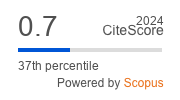Levels of Some Proinflammatory Cytokines in Obese Women with Polycystic Ovary Syndrome after Metformin Therapy
Keywords:
PCOS TNF-α hs-CRP IL-6 MetforminAbstract
Background: Polycystic ovary syndrome is a heterogeneous disorder and its etiology appears to be complex and multifactorial; characterized by hyperandrogenism, chronic anovulation and infertility. It’s associated with evidence of low-grade chronic inflammation, as indicated by the presence of elevated levels of high sensitive C- reactive protein levels, interleukin-6 and tumor necrosis factor-α. The source of excess circulating tumor necrosis factor-α in obese Polycystic ovary syndrome patient is likely to be the adipose tissues while in lean women increased visceral adiposity has been proposed as a source of excess tumor necrosis factor-α.Objectives: to evaluate the levels of high sensitive C- reactive protein, tumor necrosis factor-α and interleukin-6 in patients with polycystic ovary syndrome before and after treatment with metformin; with emphasis on their relationship with the improvement in ovulation rate and body mass index in Iraqi women.Methods: 69 Iraqi females with PCOS, with mean age of 25.8±4.4 years, body mass index 31.14±2.23 kg/m2 and insulin resistant equal to 3.15±0.25. Additionally, 30 healthy fertile women BMI= 26.87±3.1 kg/m2 and mean age 23.4±2.8 years), the patients were treated with metformin 1500 mg/day for 3 months. Blood samples were obtained in the morning subsequent to an overnight fasting at baseline and at the end of the 12 weeks period of treatment, the samples were analyzed for plasma glucose level estimated by enzymatic colorimetric kit, while serum insulin , TNF-α, IL-6 , hs-CRP, Progesterone and sex hormone binding globulin . Results: BMI values were significantly increased at baseline value in patients (P<0.05) compared with healthy controls, then significantly decreased (12.9%) after treatment compared with baseline values, HOMA-IR index were significantly elevated in patients group at baseline compared with control, and significantly decreased by 17.4% after treatment. Regarding the influence of metformin on inflammatory markers, the present study demonstrated significant elevation of baseline levels (P<0.05) of TNF-α, hs-CRP and IL-6 compared with controls, and the baseline levels significantly decreased after treatment by 16%, 38% and 37% respectively. Meanwhile, sex hormone binding globulin levels were significantly decreased in PCOS patients compared with healthy controls, and significantly increased after treatment by 16.6%, also progesterone levels decline at baseline compared with control group, and it was increased significantly after treatment by 24%.Conclusions: The study detects an increased level of inflammatory cytokines, SHBG and decrease level of progesterone in Iraqi females with PCOS, and metformin therapy improves serum levels of the inflammatory cytokines associated with increased ovulation rate.













